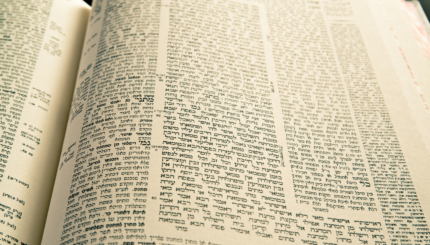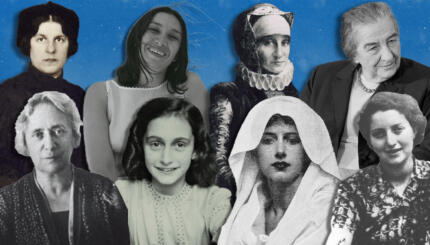Reprinted with permission from Inventing Jewish Ritual (The Jewish Publication Society).
In creating new rituals, Jewish feminists have alternated between two approaches: adaptation of existing rituals and creation of new ones. In adaptation, the Jewish practices men have traditionally performed are made available for women. (If men wore prayer shawls and yarmulkes, now women would; if 10 men constituted a prayer quorum, now women would be counted too.)
Feminists critical of adaptive rituals, sometimes referred to as "add women and stir," have questioned the value of putting their energies into either making women’s versions of the already existing, privileged rituals that Jewish men are performing, or fighting for the right to perform those rituals in communities that forbid them to do so. They would ask: Even if all the battles are successfully fought, have Judaism’s patriarchal assumptions been challenged? Instead, they have proposed creating "distinctively female alternatives," derived from insights and practices that emerge out of the lives of Jewish women, which will transform Judaism into what Judith Plaskow described as "a religion that women as well as men have a role in shaping."
Years of negotiating between these approaches have compelled feminists to articulate a vision of what a flourishing Jewish women’s spirituality might look like. That task is ongoing. For the time being, both paths–adaptation and creation–are still followed.
With your help, My Jewish Learning can provide endless opportunities for learning, connection and discovery.
Jewish feminists continue to ask these core questions that pertain to new ritual: How can we avoid replicating the mind/body split of traditional Judaism and still honor the many experiences particular to women’s bodies? What place will the law have in feminist Jewish practices? Should a patriarchal, transcendent God be replaced in feminist ritual and theology by an immanent spiritual presence? If aspects of the traditional separation of genders benefit women, should they be maintained?
Having created a body of satisfying rituals for women, Jewish feminists are currently asking a new question: how might the fruits of their labors–egalitarianism, acknowledging bodily experiences, marking life’s unmarked passages, and attention to healing and inclusiveness–be effectively brought back to the entire community to revise the Judaism that is shared by men and women alike?
Characteristics of the New Rituals of Jewish Women
The new women’s rituals that have been evolving since the 1970s share certain common characteristics:
1. Marking the unmarked. Many women’s rituals mark events linked to women’s bodily experiences that previously have not evoked formal Jewish responses. They include the onset of menstruation, pregnancy, giving birth, menopause, miscarriage, infertility, hysterectomy, healing after rape and abuse, and completing a course of cancer treatments, Furthermore, the rituals often recognize the unmarked moments of a woman’s social life: becoming a mother, a lover, a divorcee, a widow, or a mourner.
2. Fostering community. Often held in all-women groups, the rituals encourage supportive sharing and telling one’s own story. This aspect reflects the influence of the consciousness-raising sessions of early secular feminism and has been preserved primarily in Rosh Hodesh groups, Evoking the mood of a support group that has come together, the rituals emphasize the participation of a community of equals, even when the ritual highlights the experience of one woman, They create opportunities for women’s bonding across lines that might otherwise be divisive, such as age, economic class, marital status, sexual orientation, and denomination or ideology," They strive to be inclusive, so that even those without Judaic knowledge will feel comfortable.
3. Allowing for improvisation and personalization. Most new women’s rituals are not meant to change or challenge laws or be legally binding, Thus, they do not have fixed liturgies, specific words that must be said, or a series of actions that must be performed to make the ritual valid. The preference for improvisation, personalization, and choice that the rituals reflect leaves a wide opening for creativity. For example, suggestions for Rosh Hodesh meetings that one might receive from the Hadassah organization or a newer group, "Moving Tradition: It’s a Girl Thing" (promoting Rosh Hodesh observance among young girls) are often presented as inspirational templates from which one can pick and choose. Likewise, in Debra Nussbaum Cohen’s book of rituals for baby daughters, the reader is given a template for most ceremonies, as well as "hundreds of elements to consider incorporating, in an easy-to-follow menu of options."
4. Privileging the spirituality of the individual over that of the entire Jewish people. While the new women’s rituals foster the growth and cohesive feelings of communities, they tend to emphasize the psychological and spiritual well-being of individuals within the group. Thus, new rituals typically address questions of personal meaning rather than concerns about Klal Yisrael, the good of all Jews. In fact, the benchmark of a new ritual’s appropriateness is generally the subjective response, "It feels right to me." Because of the emphasis on the individual over the group, it is worth noting that American Jewish feminists have not attempted to create brand-new holidays to be celebrated by all Jewish women or all Jews.
5. Taking place in less regulated space. The earliest new women’s rituals typically took place in homes or in nature. They were enacted away from institutionalized settings, both physically and metaphysically, so as to avoid being subject to rabbinic, communal, or male jurisdiction. There were feminist seders that moved from one woman’s apartment to another each year and then expanded so that they now take place in community centers and catering halls. There are pre-wedding mikveh parties that take place, among women friends, in the ocean, under the moonlight. There are gatherings of Lubavitch Hasidic women in basement recreation rooms for designing and decorating Miriam’s tambourines. Only later, as the new rituals have become more familiar, are they held in synagogues and Jewish community centers.
6. Being self-explanatory and easy to use. The new women’s rituals are highly user-friendly. To be included as a celebrant, one need only show up, be ready to experience something new, and be willing to temporarily suspend judgment and critique. Effective leaders acknowledge the discomfort one might feel in experiencing a ritual for the first time and assure attendees that however unfamiliar the ritual may be, it is linked to Jewish tradition. When women who are rabbis or ritual experts lead rituals, they often try to minimize their authority by inviting significant group participation–so that they are not experienced as emissaries of God.
The new rituals are performed in gender-neutral or female friendly English. If Hebrew verse is spoken, it is often a familiar one, like the Shehecheyanu prayer. God language is either degendered or rendered multigendered.
Like traditional rituals that often contain instructions for what to do in the body of the liturgy, and explain why the ritual is done and what its symbolic actions and objects mean (the Passover seder comes readily to mind), the new women’s rituals often contain within them instructions, clues for interpretation, and allusions to Jewish history or tradition. If a text is distributed, it will explain everything one needs to know, and Hebrew will be translated and transliterated.
Materials needed for the new ritual are familiar: paper, candles, matches, wine, spices, incense, cups, tambourines, and cloth. One need not travel to Jerusalem or Borough Park or even ponder how to buy those things that are locked inside the glass case of a synagogue gift shop, as they can nearly all be easily found.
7. Allowing for spontaneity. The new women’s rituals are often flexibly timed. They are created when a situation calls for ritual marking and intensification and are set to fit the emotional needs and schedules of the celebrants. A baby girl’s naming ceremony, for instance, rarely takes place on the eighth day of the infant’s life or during the first time Torah is read after birth. Instead, it is usually held when the mother has regained her strength after childbirth and when beloved relatives can conveniently arrive. The feminist seder is also flexible: it can take place before Passover or during one of the intermediate days-any time that does not place it in direct competition with family observance.
8. Promoting a Jewish women’s agenda. As living performances, the new rituals promote a women’s agenda within the context of Judaism. That agenda includes respecting women’s needs, contributions, and insights. Seeking to address all ritual scenarios in which a woman’s status or her agency is in any way diminished under Jewish law, the rituals recognize that if Jewish women have been silenced, belittled, objectified, or demonized in the past, this is no longer acceptable. In some cases, parallel rituals for women have been created as rectifications, and in others, variations on the ritual have been introduced.
This maneuvering–often carried out through fresh readings of traditional sources–can be a formidable project for women who identify as "halakhic Jews" and are reluctant to be viewed as radical or disloyal. But it can be no less daunting for women of other traditions with entrenched practices and assumptions. While Jewish feminists rarely invoke "the will of God" as justification for particular rituals, I believe–and here I speak personally–that to many women, the creation of a Judaism suffused with women’s gifts feels divinely sanctioned, even ordained.
Hasidic
Pronounced: khah-SID-ik, Origin: Hebrew, a stream within ultra-Orthodox Judaism that grew out of an 18th-century mystical revival movement.
seder
Pronounced: SAY-der, Origin: Hebrew, literally "order"; usually used to describe the ceremonial meal and telling of the Passover story on the first two nights of Passover. (In Israel, Jews have a seder only on the first night of Passover.)
Torah
Pronunced: TORE-uh, Origin: Hebrew, the Five Books of Moses.


